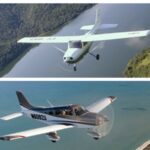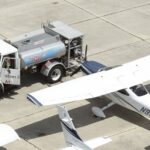This is an overview of all the pros and cons I’ve heard about choosing a high-wing plane like a Cessna or a Cub versus a low-wing GA airplane like a Piper Cherokee or Grumman Tiger. I will also give my honest opinion based on flying both types of planes.
Fuel Management
High wings have an advantage here, as most high-wing airplanes will only require boost pumps during certain stages of flight—not constantly—thus removing a potential mechanical failure point. This advantage mostly applies to carbureted engines, which often don’t need fuel pumps in high-wing planes. However, this does not hold true for fuel-injected engines. It’s a solid argument for extra safety.
Changing fuel tanks is also simplified in a high-wing design, as most high-wing planes often include a “Both” setting that allows you to pull fuel from both tanks at once, eliminating the risk of fuel exhaustion caused by forgetting to switch tanks. However, if your high-wing plane does not have a “Both” setting, this advantage no longer applies, and you’ll need to switch tanks manually every 30 minutes or so—just as you would in a low-wing plane.
The View
If you enjoy flying below 5,000 feet AGL and admiring the terrain, a low-wing design may obstruct your view. While you’ll eventually get used to the wing being in your line of sight and may hardly notice it anymore, the difference becomes clear when switching between high-wing and low-wing planes.
An often-overlooked downside of high-wing planes is that you can’t easily see your fuel caps. This can be important because forgotten or improperly secured fuel caps can cause fuel to be siphoned out during flight. In low-wing planes, this issue is addressed simply by glancing at the caps before flight. While this detail may not matter to everyone, it’s something to keep in mind.
Overall, I give this one to high-wing planes unless you’re extremely concerned about fuel caps being left unsecured. As for other visibility-related considerations, such as your ability to see landing gear, that issue can easily be resolved on low-wing planes with a small mirror, so it’s not a decisive factor.
Cost
High-wing planes, specifically Cessnas, tend to be more expensive upfront. Since Cessnas are widely used for flight training, their demand keeps their prices high. If you’re comparing starter 3-4 seater planes like a Cessna 172 or a Piper Cherokee 160/180, the Cessna will typically cost 10–20% more. This is largely due to the current demand for trainers and the preference for C172 models in flight schools’ inventories.
Annual inspections and maintenance costs are roughly the same for both high-wing and low-wing planes. However, when it comes to upfront costs, low-wing planes like the Piper PA-28 tend to be cheaper for comparable performance. Therefore, I give this category to low-wing planes.
Accessibility
Accessibility often comes down to personal preference, but it’s an important factor to consider. If you’re young and spry, you might have no issue climbing onto a wing and sliding across it to get inside a one-door Piper. However, if you’ve accumulated the wear and tear of life over the years, this task may prove frustrating or physically taxing.
I also often fly with my 80-pound dog, and getting him onto the wing and into the back seat of a low-wing plane is nearly impossible. In contrast, high-wing planes typically have two doors that are directly accessible without needing to climb over anything. For some pilots, this ease of entry is non-negotiable. For me, the accessibility of a high-wing design is a must in this regard.
That said, this factor is entirely subjective. If you’re comfortable with a single door on the wing, you might save $20,000 upfront by opting for a Piper Cherokee PA-28 instead of a comparable Cessna 172.
Other Considerations
There are always slight differences between models and systems, such as how certain Piper planes barely need carb heat while Cessnas seem addicted to it, or how Cessna’s seat rails require frequent maintenance checks. However, such variances tend to balance out across different models, and I consider them non-issues overall.
For me, the decisive factor is the ability to comfortably get my small family in and out of the plane. Anything that makes my wife, child, or dog unwilling to get into the plane reduces the likelihood of them joining me on flights, which is a big deal. High-wing planes win for me on this front.
However, if you primarily fly solo and want to save some money, low-wing planes may be the better option for you.






